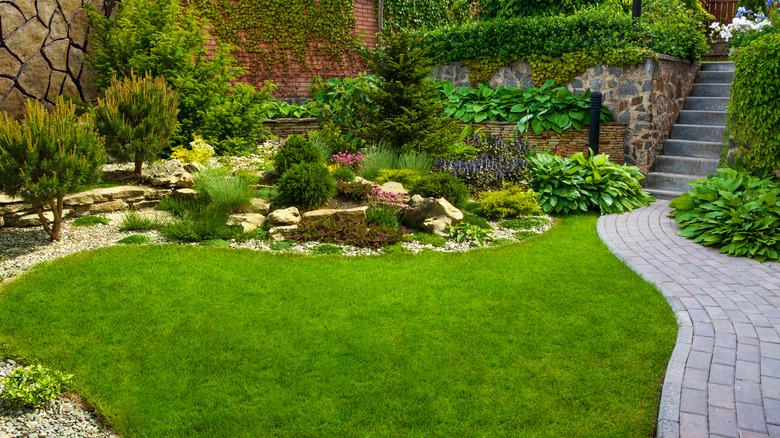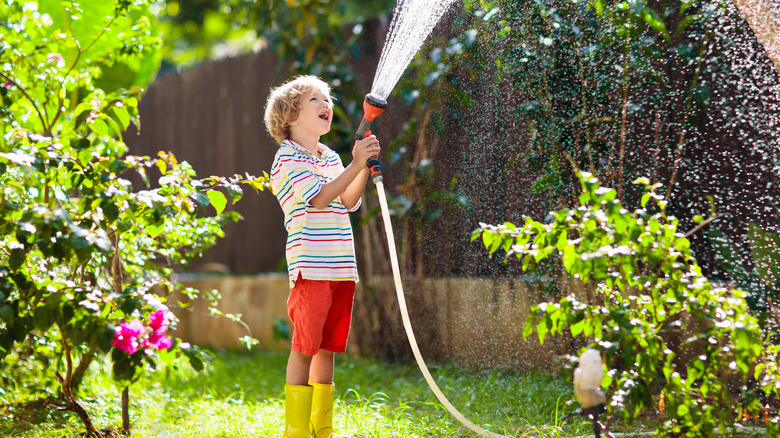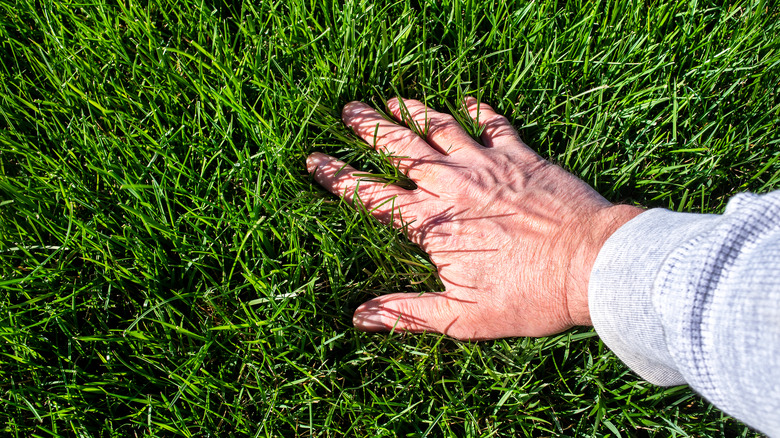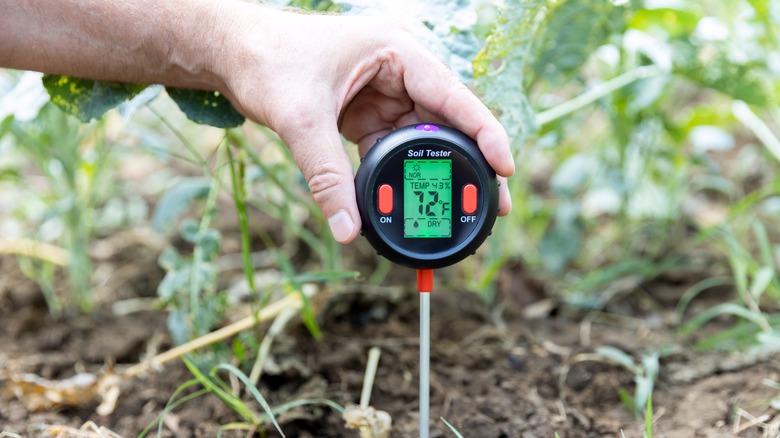When Is The Right Time To Fertilize A Lawn?
Everyone wants a yard of thick green carpet that all the neighbors envy, and it's one of the reasons that the lawn care industry continues to thrive. After all, no one knows a job like a professional who does it for a living. But if you'd like to save money and don't mind learning, DIY lawn care can be your ticket to a year-round zen experience — and the yard of your dreams.
Lush and verdant lawns have been a status symbol since long before Versailles was a palace overlooking spectacular grounds, Lawn & Weed Expert notes. From kings and queens to robber barons, captains of industry, and today's media superstars, having a great-looking lawn appears on most checklists right after getting a breathtaking home worthy of landscaping. However, the key to having a yard you can be proud of is not only knowing what to do but when to step in to lend nature a helping hand. It's the constant gardener who can see those signs and act on them quickly that separates the successes from the failures in lawn care.
How will you use your lawn?
Many homeowners believe that one of the telltale differences between a house and a home is having an outdoor space where you and your family can come together and spend time. Indoors, that can mean a media room, your kitchen, a recreation room, or an exercise room for your elliptical machine, weights, and sports gear. But a yard that's been well-tended incorporates all of those pastimes and brings them outdoors for the entire family to enjoy. You'll make memories here. In an ideal world, there'll be part of the yard that gets abundant sun in the afternoon hours for play; shade where you can dine al fresco, sip a cool drink, and work or grill, offset by an area dedicated to nothing more than the view you've created with your own two hands.
But, much more than what's indoors — limited by its walls, floors, doors, and ceilings — what you see outside is going to depend mainly on what you have the will and time to bring to life. The entire point of a well-kept lawn is to demonstrate beauty and symmetry. If a home is a jewel, then a robust lawn can be considered the one setting that helps it shine most brilliantly. And remember, a healthy lawn is more than a pleasure to behold: Your grass also captures dirt and releases copious amounts of oxygen, per Pennington.
How to care for your lawn
Family Handyman provides directions to ensure that you're working smarter, not harder, to keep your lawn photo-op ready. Like others, they caution against shortcuts and emphasize that timing is just as important as treatment. Make sure you understand your soil and climate and know that you should plant cool-season grass from late summer to fall. Grasses that thrive in hotter regions do best when planted just before and into early summertime.
Even how you mow makes a difference because a blade's height from the ground impacts growth. Keeping your blade between 1.5 inches and 2 inches in the first season of mowing puts more sunlight where it needs to go and removes grass that's already dead. For the remaining season, your blade should be at least 2 inches from the ground; return to the original setting for that last cut of the fall. Also, make sure your mower blades stay sharp.
Beyond that, remember that lawns like a thorough soaking more than a frequent sprinkle. Deep soaks permeate the soil and promote root growth as your grass searches for sub-surface moisture. Sprinkling won't do that as water could evaporate, depending on when you give it a drink (the best time is usually mornings). These broad concepts can be fine-tuned by learning more about your lawn. So, consulting local seed sellers may be the best way for you to ask questions, get answers and make follow-up queries.
Mind the grass variety
The pros at Lowe's will tell you that growing a lush lawn is less about having a green thumb and more about following science and weather patterns. Not every grass does well in every climate. Some grasses grow most robustly up north, including fine fescue, tall fescue, bluegrass, and perennial ryegrass. And some prefer the warm weather of the south. Among those, you'll find common bermudagrass, hybrid bermuda, bahia, zoysia, and centipede. Pennington notes that while bluegrass creates a dense and rich lawn, the tall rescue variety has a coarser texture and is the industrial standard for economical lawns. Similarly, bermudagrass is drought-resistant and thrives in direct sun, but zoysia shows its greenery sooner than other grass types and stays green longer in fall.
Most experts advise against taking a one-size-fits-all approach. Sure, you may grow a lawn, but it won't reach its potential if you try to force the planting and watering schedule to conform to your will. Most retailers selling seeds know what grasses work well in your climate, and the really good ones will ask questions that go a step further. For example, is your lawn for a view or for romping with kids and pets? By day, does it get more direct sunlight or shade? All of these contribute to what kind of grass you should purchase and how you should care for your lawn once it starts to appear, so ensure you consult with the seller when purchasing your grass.
Grass type and soil determine your fertilizer
With the basics in mind, lawn maintenance is simple. The first step is knowing the temperature of the ground outside. You can buy a soil thermometer, but many universities also have departments that make it their business to know the local ground temperatures. Second, determine what type of grass you're tending. There are summer and cooler grasses, as mentioned, but many lawns can contain several types. So, again, consulting the varieties, as explained by Pennington, can help you identify yours. Once you know what's underfoot and the ground temperature has reached a stable 55°F, you're ready to begin, and the best time for the first treatment precedes or coincides with seeding.
Some recommend fertilizing as little as twice a year, while others (Popular Mechanics, for one) say a half dozen treatments yield the best results. They agree the best time to bathe your lawn in chemicals is during its growth phase. Spring is best for warm-season grasses, and closer to summer is optimal for cooler varieties. Still, it's always wise to remain abreast of the weather because you don't want to fertilize during rainstorms or drought.
In terms of fertilizer, HGTV advises that the most important component in lawn health is adequate nitrogen. So when you're examining individual products, the labels should feature three numbers prominently to tell you the percentage of potassium, phosphate, and nitrogen. It's always best to feed it slow-release granules, and using a spreader (and gloves) is recommended.




